Newsroom Image Library - CDC Leaders & Scientists
These images are in the public domain and are thus free of any copyright restrictions. As a matter of courtesy, we request that the content provider be credited and notified of any public or private usage of an image.
For more information on an image, including the content provider(s) and extended descriptions, please enter the image’s PHIL ID number in the search box in the Public Health Image Library. If you need assistance, please e-mail media@cdc.gov or call 404-639-3286.
Nancy Cox, Ph.D
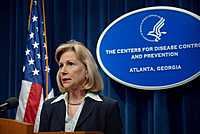
PHIL ID # 11210
Photo Credit: James Gathany, Centers for Disease Control and Prevention
Download High Resolution
Description:
This 2009 photograph depicts the Chief of the Influenza Branch for the National Center for Infectious Diseases, Nancy Cox, Ph.D., at the podium during a Centers for Disease Control (CDC) press briefing held in order to discuss an update in the investigation of cases of swine influenza in California and Texas. CDC issued an MMWR dispatch on Tuesday, April 21, 2009. This briefing updated information included in the dispatch.
Rear Admiral Anne Schuchat, M.D.
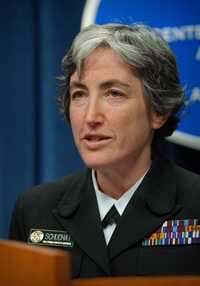
PHIL ID # 11207
Photo Credit: James Gathany, Centers for Disease Control and Prevention
Download High Resolution
Description:
This 2009 photograph depicts the Interim Deputy Director for Science and Public Health Program, Rear Admiral Anne Schuchat, M.D., at the podium during a Centers for Disease Control (CDC) press briefing held in order to discuss an update in the investigation of cases of swine influenza in California and Texas. CDC issued an MMWR dispatch on Tuesday, April 21, 2009. This briefing updated information included in the dispatch.
CDC Scientist in BSL-4 Lab
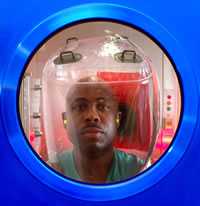
PHIL ID # 10721
Photo Credit: James Gathany, Centers for Disease Control and Prevention
Download High Resolution
Description:
CDC scientist Thomas Stevens peers from inside the autoclave room of the BLS-4 laboratory to the outer corridor.
CDC Scientist in BSL-4 Lab
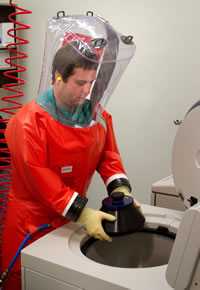
PHIL ID # 10720
Photo Credit: James Gathany, Centers for Disease Control and Prevention
Download High Resolution
Description:
CDC scientist Scott Smith laces a rotor containing tubes of virus particles and cellular debris into a high speed centrifuge.
CDC Scientists working in BSL-4 Lab

PHIL ID # 10723
Photo Credit: James Gathany, Centers for Disease Control and Prevention
Download High Resolution
Description:
CDC scientists connect to a supportive air hose to breathe air and to maintain positive pressure inside the protective, BSL-4 lab suit.
CDC Scientist in BSL-4 Lab
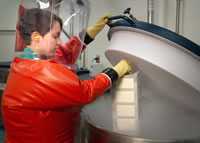
PHIL ID # 10724
Photo Credit: James Gathany, Centers for Disease Control and Prevention
Download High Resolution
Description:
A CDC scientist inserts a rack of boxes containing biological stocks into the liquid nitrogen freezer for storage.
CDC Scientist in BSL-4 Lab
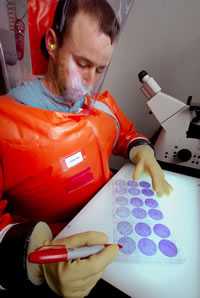
PHIL ID # 10725
Photo Credit: James Gathany, Centers for Disease Control and Prevention
Download High Resolution
Description:
CDC scientist Zach Braden counts viral plaques within fixed monolayers of cells over a light box in order to titrate a viral stock.
CDC Scientist in BSL-4 Lab
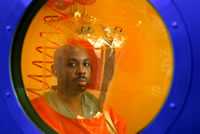
PHIL ID # 10726
Photo Credit: James Gathany, Centers for Disease Control and Prevention
Download High Resolution
Description:
CDC scientist Thomas Stevens peers from the chemical decontamination shower to the suit change room.
CDC Scientist in BSL-4 Lab
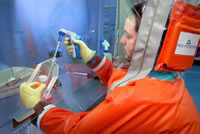
PHIL ID # 10727
Photo Credit: James Gathany, Centers for Disease Control and Prevention
Download High Resolution
Description:
CDC scientist Scott Smith manipulates a flask of cells used for experiments with live virus.
CDC Scientist in BSL-4 Lab
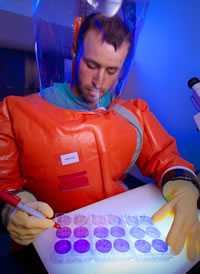
PHIL ID # 10728
Photo Credit: James Gathany, Centers for Disease Control and Prevention
Download High Resolution
Description:
CDC scientist Zach Braden counts viral plaques within fixed monolayers of cells over a light box in order to titrate a viral stock.
CDC scientists examine HIV samples
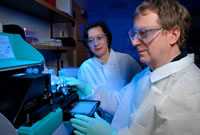
PHIL ID # 10022
Photo Credit: James Gathany, Centers for Disease Control and Prevention
Download High Resolution
Description:
Depicted in this 2007 photograph is CDC microbiologist Dr. Davis Lupo, shown using a luminometer to measure HIV infection of human cells in vitro, while Lee Lam observes. By employing various chemical reactions to the laboratory cell sample, the release of energy, in the form of emitted light, or bioluminescence, is then measured by this luminometer in quantitative units known as RLUs, or “relative light units.” Dr. Lupo and Ms. Lam are National Center for HIV/AIDS, Viral Hepatitis, STD, and TB Prevention (NCHHSTP) staff members, who work inside the center’s Laboratory Branch (LB).
CDC microbiologist working in a BSL-3 Lab
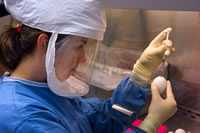
PHIL ID # 8675
Photo Credit: Greg Knobloch, Centers for Disease Control and Prevention
Download High Resolution
Description:
In this photo, Dr. Taronna Maines, a microbiologist in the Influenza Branch at the Centers for Disease Control and Prevention, is conducting an experiment inside a biological safety cabinet (BSC) within the Biosafety Level 3-enhanced laboratory. The airflow within the BSC helps prevent any airborne virus from escaping the confines of the cabinet. Dr. Maines was inoculating 10-day old emryonated hen′s eggs with a specimen containing an H5N1 avian influenza virus. This experiment was part of a study to investigate the pathogenicity and transmissibility of newly emerging H5N1 viruses. Identification of genetic markers affecting the ability of H5N1 viruses to transmit efficiently will help in the early identification of emerging H5N1 viruses with pandemic potential. Information gained from this study is important for pandemic preparedness.
CDC scientist examining specimens in BSL-3 Lab
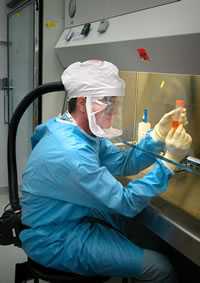
PHIL ID # 7988
Photo Credit: James Gathany, Centers for Disease Control and Prevention
Download High Resolution
Description:
This 2005 photograph of the Centers for Disease Control and Prevention′s Dr. Terrence Tumpey, one of the organization′s staff microbiologists, shows him examining reconstructed 1918 Pandemic Influenza Virus inside a specimen vial. Dr. Tumpey, here seen in a Biosafety Level 3-enhanced laboratory setting, works beneath a flow hood, which pulls air from outside the hood into the hood′s confines, and is then filtered of any pathogens before being re-circulated inside the self contained laboratory atmosphere.
CDC laboratorians working in a BSL-4 Lab

PHIL ID # 6638
Photo Credit: James Gathany, Centers for Disease Control and Prevention
Download High Resolution
Description:
This image depicts two Centers for Disease Control and Prevention laboratorians, Luanne Elliot and Dave Auperin, as they work under a flow hood inside one of the CDC′s BSL-4 (Bio Safety Lab) laboratories. CDC scientists working in the biosafety labs must wear protective clothing and head gear, and are supplied air via overhead lines that plug into the suit. The flow hood pulls air into the experimental area by creating a negative pressure, thereby, preventing pathogens from getting out into the general laboratory environment.
CDC laboratorian working
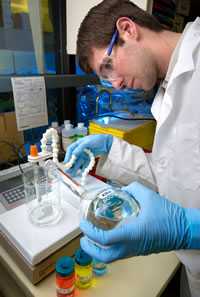
PHIL ID # 7294
Photo Credit: James Gathany, Centers for Disease Control and Prevention
Download High Resolution
Description:
Jason Tully, a CDC laboratorian, is shown here using the pH meter in order to prepare a buffer solution in the Personal Care Products Laboratory (PCPL) located in a CDC lab on the organization′s Chamblee, Georgia campus. The Personal Care Products Laboratory (PCPL) is part of the Organic Analytical Toxicology Branch (OATB) in the Division of Laboratory Sciences (DLS) of the Centers for Disease Control and Prevention (CDC). The Organic Analytical Toxicology Branch conducts research and develops methods for analyzing selected synthetic and naturally occurring organic chemicals and their metabolites, or reaction products in blood or urine.
- Page last reviewed: February 28, 2014
- Page last updated: February 28, 2014
- Content Source:



 ShareCompartir
ShareCompartir